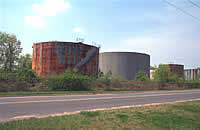Waste Site Cleanup & Reuse in New England
Glastonbury Riverfront Community Center - Glastonbury, CT
(June 2006)
Programs: EPA
Targeted Brownfield Assessment
Grant Recipient: Town
of Glastonbury (contacts)
Summary: A former oil storage tank farm site
was cleaned up and redeveloped into a community center and park.
The former Field Holstein Property in the Town of Glastonbury, Connecticut was the site of a bulk petroleum storage facility containing 15 above-ground oil storage tanks - an ‘eyesore' with extensive soil and groundwater contamination.
This brownfield site borders the scenic Connecticut River, making it a potentially valuable public asset if it could be remediated to stringent state standards. However, changing public perception was key. To be accepted as the location of a proposed Community Center and Riverfront Park site, the public had to change its opinion of the site from a contaminated liability, to a location safe for recreational activities.
The EPA provided a Targeted Brownfields Assessment grant in the amount of $84,905 to determine the issues at hand. The resulting Remedial Action Plan (RAP) took an innovative approach, as opposed to the following three more conventional schemes. The conventional approach of excavation and off-site disposal of more than 30,000 cubic yards of contaminated soils would require excavation well below the groundwater table - prohibitive due to costs, permitting requirements and constructability issues. On-site bioremediation of soil and groundwater wouldn't achieve the Center's construction schedule. And a pump-and-treat groundwater remediation system would have meant long-term cost and operational burdens.
The selected remediation plan was on-site relocation of contaminated soils exceeding Direct Exposure Criteria (RDEC); removing only soils exceeding the Pollutant Mobility Criteria (PMC); and mitigating contamination seepage into the River adjacent to the site.
To provide enough space onsite to relocate all RDEC soils while avoiding creating new contaminated footprints, the plan specified mounding 4 feet of clean fill above these soils; this created a centrally-located amphitheatre that provided a physical feature adaptable for future park use, and off-site disposal requirements were cut nearly in half, saving about $625,000. Secondly, a small volume of soil exceeded the criteria for PCBs, precluding them from onsite disposal – these were removed and disposed of off-site. And thirdly, to mitigate contaminated groundwater, the project includes a passive “funnel and gate” system, an 850-foot-long barrier wall that creates a three-dimensional barrier to groundwater flow; by directing impacted groundwater to specific locations for oil collection without pumping, this eliminated conventional “treatment” system monitoring and O&M costs and minimized construction complexity.
With this successful project, public perception changed from an eyesore to a safe venue for the community, with planned redevelopment for public access and recreational uses. A Riverfront Park will give residents access to the River for recreational activities, and the Community Center will provide a place for large community gatherings. A further benefit relates to the significant development pressure on the Town's remaining open space - by electing to remediate a Brownfield site for the Community Center, the Town not only cleaned up a contaminated property, but also preserved a large amount of its remaining open space.
Timeline:
-
1999: The Town of Glastonbury acquired the Field Holstein Property.
-
Feb 2001: Phase I EPA Targeted Brownfields Assessment (TBA) was completed.
-
2001: The town removed petroleum tanks, and completed the Remedial Action Plan (RAP).
-
Feb 2002: Phase II EPA Targeted Brownfields Assessment (TBA) was completed.
-
June 2003: The town opened remediation bids.
-
Mar 2004: Remediation activities were completed.
-
2005: The project was a 2005 E3 Competition Winner of an Honor Award – Small projects, from the American Academy of Environmental Engineers.



